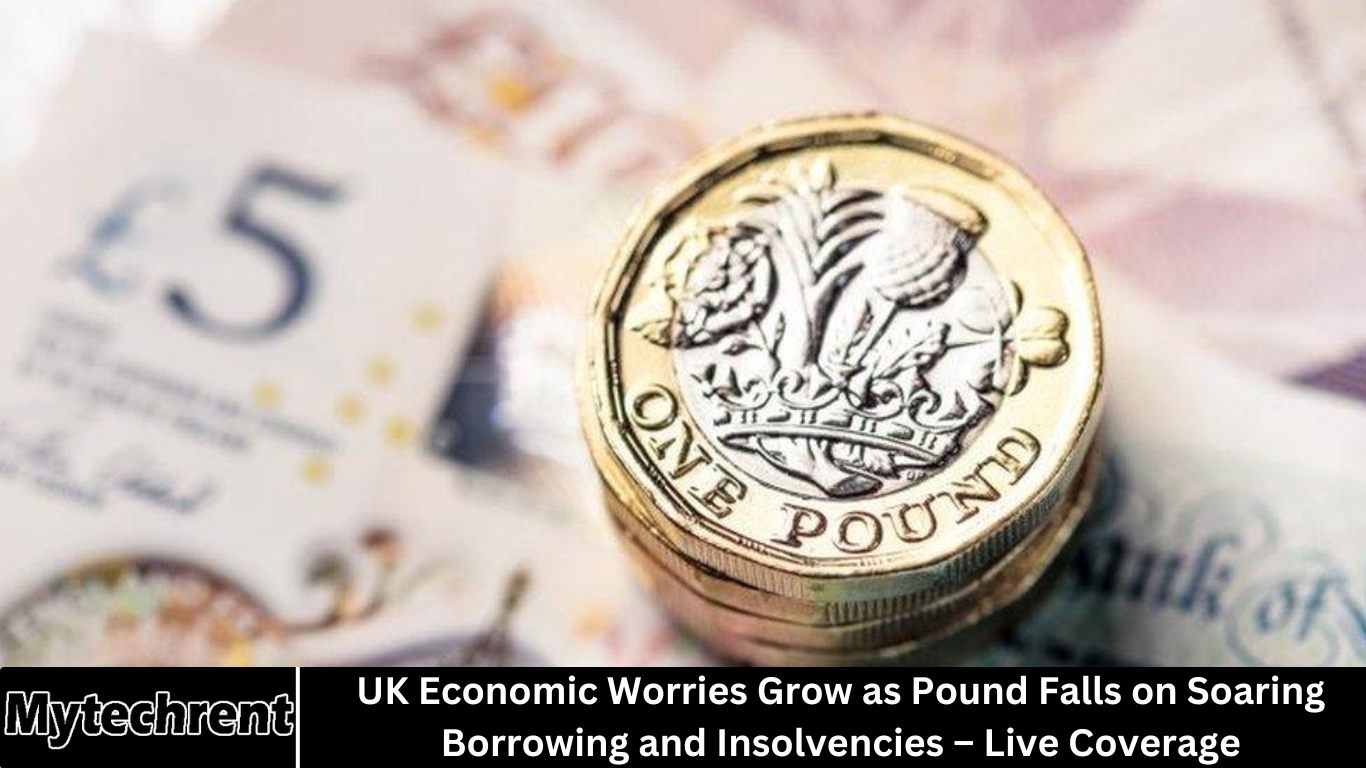The British pound has experienced a sharp decline as fresh economic data from the UK government reveals a surge in public borrowing and a worrying rise in corporate insolvencies.
- 1. Understanding the Data: Why UK Borrowing Surged in August
- 2. Why the Pound Is Falling: Investor Confidence Slips
- 3. Corporate Insolvencies Surge: A Sign of Deeper Trouble
- 4. Market Reaction: Stocks Slip, Bond Yields Climb
- 5. Analyst Reactions: Is the UK Heading Toward Stagflation?
- 6. Political Fallout: Government Faces Heat Over Economic Management
- 7. How This Impacts Everyday Britons
- 8. What’s Next for the Bank of England?
- 9. Global Context: How the UK Compares
- Frequently Asked Question
- Why is the British pound falling in 2025?
- How much did UK government borrowing increase in August 2025?
- What impact do rising corporate insolvencies have on the UK economy?
- How does increased borrowing affect the UK’s financial stability?
- Will the Bank of England raise interest rates due to the current economic situation?
- How does the fall in the pound affect UK households?
- Is the UK heading into a recession or stagflation?
- Conclusion
Economists and investors are now sounding the alarm as multiple indicators point to growing instability within the UK economy.
This live coverage explores the day’s unfolding events, key insights from analysts, market reactions, and what it all means for households, businesses, and policymakers.
More Read: BoE Alters Business Data After Release, Prompting Doubts Over Reliability
1. Understanding the Data: Why UK Borrowing Surged in August
According to the latest figures released by the Office for National Statistics (ONS), the UK government borrowed £19.5 billion in August — a sharp increase compared to the £13.3 billion borrowed in the same month last year.
This rise in borrowing is largely attributed to:
-
Higher interest payments on government debt due to inflation-linked bonds.
-
Increased spending on public services, particularly the NHS and energy subsidies.
-
Slower-than-expected tax receipts amid economic stagnation.
Chancellor of the Exchequer Rachel Reeves acknowledged the challenges, saying:
“While borrowing remains necessary to support public services and protect vulnerable households, we are committed to restoring fiscal responsibility over the medium term.”
However, critics argue that without a clear plan for debt reduction, continued borrowing will only deepen the UK’s structural deficits.
2. Why the Pound Is Falling: Investor Confidence Slips
The British pound took a hit following the release of the borrowing data. By mid-morning trading on October 5, the GBP/USD exchange rate had dropped to $1.21, marking its lowest point since April 2025.
Currency traders cited several factors for the pound’s decline:
-
Rising fiscal risks tied to excessive borrowing.
-
Concerns over the UK’s slowing GDP growth forecast, now trimmed to 0.3% for Q4.
-
Global investor flight to the US dollar, viewed as a safe haven amid global economic uncertainty.
Forex strategist Amanda Li at HSBC commented:
“The pound is under pressure not just due to local fiscal concerns, but also because the UK economy lacks strong growth catalysts right now. Inflation is sticky, consumer demand is weakening, and Brexit-related trade challenges still linger.”
3. Corporate Insolvencies Surge: A Sign of Deeper Trouble
Another worrying development came in the form of rising corporate insolvencies. According to The Insolvency Service, 2,456 companies in England and Wales filed for insolvency in August — a 15% increase compared to the same month last year.
Sectors hardest hit include:
-
Retail and hospitality, still struggling from post-pandemic demand shifts.
-
Construction, impacted by higher interest rates and material costs.
-
Small and medium enterprises (SMEs) facing cash flow challenges.
Mark Wharton, Director at Resilience Business Advisors, warns:
“These insolvency figures are a canary in the coal mine. Many businesses are overleveraged, dealing with rising wage demands, and unable to pass on costs to price-sensitive consumers.”
4. Market Reaction: Stocks Slip, Bond Yields Climb
Financial markets reacted swiftly to the economic data:
-
The FTSE 100 dipped by 0.8% as investors digested the twin threats of rising borrowing and corporate failures.
-
UK 10-year gilt yields rose to 4.62%, signaling investors are demanding higher returns to compensate for perceived fiscal risk.
-
Banking and construction stocks were among the biggest losers on the day.
The Bank of England (BoE) has not yet commented publicly, but analysts believe today’s developments will make it harder for the BoE to continue its tightrope walk between controlling inflation and supporting growth.
5. Analyst Reactions: Is the UK Heading Toward Stagflation?
Several economists now believe the UK is dangerously close to entering a stagflationary phase — where high inflation is combined with stagnant or negative economic growth.
Kathryn Brown, Senior UK Economist at Capital Economics, notes:
“The current economic cocktail of weak growth, high borrowing, and persistent inflation is deeply concerning. If insolvencies continue to rise, we could see an even sharper contraction in business investment and employment.”
This concern is echoed by credit rating agencies, which have begun reassessing the UK’s fiscal outlook. While a downgrade has not yet occurred, any movement in that direction would further pressure the pound and increase borrowing costs.
6. Political Fallout: Government Faces Heat Over Economic Management
The opposition party has been quick to seize on today’s data. Shadow Chancellor Tom Kerrigan criticized the government’s fiscal policy:
“These figures show that the government has lost control of the public finances. We need targeted, responsible investment — not reckless spending with no plan to grow the economy.”
With a general election looming in 2026, the economy is expected to dominate the political agenda. Rising living costs, stagnant wages, and the fear of job losses due to insolvencies are already fuelling public dissatisfaction.
7. How This Impacts Everyday Britons
The broader economic trends reflected in today’s data have very real consequences for everyday people:
Cost of Living:
Inflation remains stubbornly high at 4.1%, pushing up prices for food, fuel, and housing.
Employment:
A rise in company closures could translate into more job losses in the coming months, particularly in the SME sector.
Mortgages and Loans:
As gilt yields rise, fixed-rate mortgages are also becoming more expensive. The average 2-year fixed mortgage now stands at 6.3%.
Savings and Investments:
A weaker pound reduces the value of UK assets in international terms and may erode returns on investment funds with overseas exposure.
8. What’s Next for the Bank of England?
The Bank of England will convene later this month to decide on its next move regarding interest rates. Previously, there were expectations of a pause or even a rate cut, but today’s borrowing and inflation data may complicate that.
Potential Scenarios:
-
Hold rates steady to avoid deepening economic pain.
-
Raise rates slightly to reassert inflation control, risking further slowdown.
-
Introduce targeted lending support to small businesses.
Market futures suggest a 65% probability that the BoE will hold rates at 5.25%, though sentiment remains fluid.
9. Global Context: How the UK Compares
The UK is not alone in facing fiscal and economic headwinds. However, its position is particularly precarious when compared to other advanced economies:
| Country | GDP Growth (Q3 est.) | Inflation | Interest Rate | Public Debt (% of GDP) |
|---|---|---|---|---|
| UK | 0.2% | 4.1% | 5.25% | 101% |
| US | 1.4% | 3.2% | 5.50% | 123% |
| Germany | 0.1% | 3.8% | 4.25% | 67% |
| Japan | 0.5% | 2.6% | 0.10% | 266% |
While UK debt is lower than some peers, its low productivity, Brexit trade impacts, and high dependency on services make it more vulnerable to economic shocks.
Frequently Asked Question
Why is the British pound falling in 2025?
The British pound is falling due to rising government borrowing, increasing corporate insolvencies, and slowing economic growth. These factors have shaken investor confidence, leading to a sell-off in the pound and a shift toward more stable currencies like the US dollar.
How much did UK government borrowing increase in August 2025?
In August 2025, UK government borrowing rose to £19.5 billion, significantly above forecasts. The surge is attributed to higher interest payments on debt, increased public spending, and lower-than-expected tax revenues.
What impact do rising corporate insolvencies have on the UK economy?
Rising corporate insolvencies reduce employment, shrink tax revenue, and damage business confidence. A 15% year-on-year increase in insolvencies in August 2025 signals deeper financial stress, especially among small and medium-sized businesses.
How does increased borrowing affect the UK’s financial stability?
Higher borrowing increases the UK’s debt burden and can lead to higher interest rates on government bonds (gilts). This makes future borrowing more expensive and may prompt credit rating agencies to reassess the UK’s fiscal credibility.
Will the Bank of England raise interest rates due to the current economic situation?
While inflation remains high, rising borrowing and signs of economic stagnation make a rate hike risky. Analysts believe the Bank of England may pause or maintain current interest rates in its next meeting, but future decisions will depend on inflation and growth trends.
How does the fall in the pound affect UK households?
A weaker pound makes imported goods and services more expensive, contributing to inflation. This affects household budgets, especially for essentials like food, fuel, and electronics, and can reduce real wages and purchasing power.
Is the UK heading into a recession or stagflation?
Many economists fear the UK may be approaching stagflation, where stagnant growth combines with high inflation. With low GDP growth, rising insolvencies, and persistent price pressures, the risk of economic stagnation is growing.
Conclusion
The UK finds itself at a crossroads. The economic warning signs are becoming harder to ignore, and how the government and central bank respond in the coming weeks will shape the country’s financial trajectory for years to come.
For now, caution, clarity, and strategic planning are the watchwords as the nation navigates turbulent fiscal waters.








